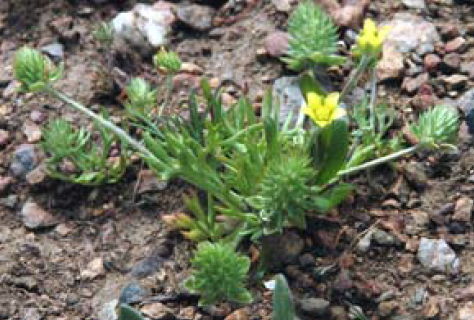
(redirected from burr buttercup)
Bur buttercup (Ceratocephalus testiculatus) has not been considered to be poisonous, but the sudden death loss of 150 ewes while grazing it prompted study of the plant. It was found that bur buttercup can be highly toxic to sheep, with a lethal dose being as little as 500 g of green plant for a 45-k. Creeping buttercup is a low-growing perennial with hairy leaves divided into three lobes. The flowers are perhaps the most identifiable feature and consist of five to 10 bright, shiny yellow petals. The flowers grow up to 1 inch in diameter and are broadly rounded at the apex.
Bur buttercup (Ranunculus testicdatus Crantz) is an alien annual species that has spread rapidly through range and crop- lands in the western United States. This species is potentially poisonous and is currently a weed in cereal grain fields. We investi- gated the germination of the achenes (seeds). Testiculata is commonly known in English as bur (or burr) buttercup, but other names include curveseed butterwort, curve-seed buttercup and little bur. Named after the inflorescences which ripen into hard, spiny fruits or burs, the generic name Ceratocephala is derived from the Greek keras or keratos meaning a horn and kephale meaning the head. Bur Buttercup Ranunculus testiculatus. Bur buttercup is a county declared weed in Converse county in Wyoming. Photo by Richard Old, XID Services, Inc., Bugwood.org.
Also found in: Dictionary, Thesaurus, Encyclopedia.
bur
[ber]bur
(ber), This spelling is preferred to burr.burr
A drill bit used to cut hard tissues (e.g., enamel, bone) in dentistry or orthopaedics.burr
A drill bit used to cut hard tissues–enamel, bone in dentistry or orthopaedicsbur
( bŭr)
bŭr) Burr Buttercup Picture

Want to thank TFD for its existence? Tell a friend about us, add a link to this page, or visit the webmaster's page for free fun content.
Link to this page:
Common Name(s):
Bur Buttercup
Curveseed Butterwort
Scientific Name:
Bur Buttercup Removal
Ceratocephala testiculata (Crantz.) Bess.
Scientific Name Synonyms:
Ranunculus testiculatus Crantz.
Ceratocephalafalcata auct. non (L.) Pers.
Ceratocephalaorthoceras DC
Ranunculusfalcatus auct. non L.
Symbol:
CETE5
Description:
Life Span: Annual
Origin: Introduced
Growth Characteristics: Bur buttercup is a winter annual that emerges, flowers, and sets fruits in the spring, when temperatures climb into the 45-50 degree range. Plants only grow to be 2 or 3 inches tall. They often occur in dense mats which cover large areas of the ground.
Ceratocephala Testiculata
Flowers: Each blossom usually has 5 bright yellow petals. The flowers are very tiny, measuring less than a quarter inch long.
Fruits/Seeds: At maturity, each blossom develops into a bur, which dries and turns brown. ½ - ¾ inch long.
Leaves: Divided into finger-like segments, resembling a bird’s foot, and covered with fine hairs.
Burr Buttercup Weed
Stems: Short, leafless
Ecological Adaptions:
Bur buttercup has become widespread in gardens, small grains, pastures, waste areas, and along roadsides.
Soils: Widespread
Uses and Management:
This plant contains ranunculin, which changes into a highly toxic compound, protoanemonin, when the plant is crushed. Sheep have been poisoned and have died in the western United States after ingesting aboveground plant material. This plant is considered highly toxic. Signs of poisoning include anorexia, labored breathing, diarrhea, dyspnea, recumbency, weakness, and death.
It is important to control bur buttercup stands before they produce flowers and seeds. Hoeing, pulling, and digging can control it, or it can be sprayed with 2,4-D, Ally, Banvel + 2,4-D, Finale, Liberty, or Roundup. Burning is also a good form of control, if your area permits.
